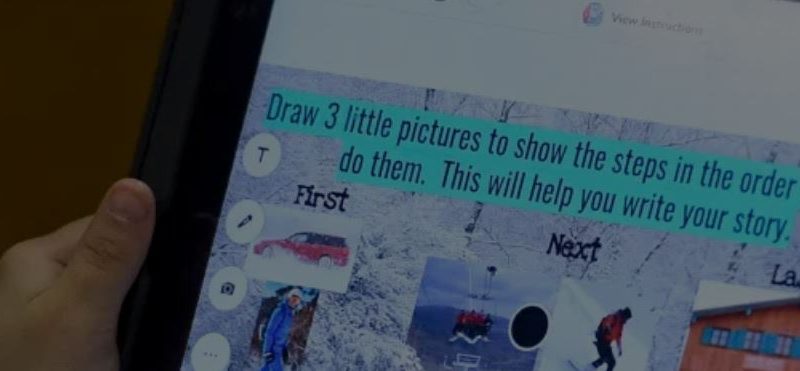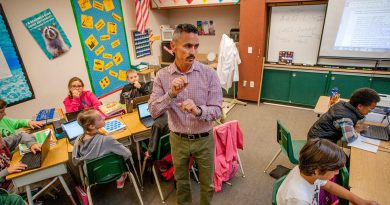TEACHER VOICE: One teacher’s advice to help students not just survive, but thrive in remote learning
At a school on an American Indian reservation in Arizona, a buddy system, asset-based teaching and focusing on the little things make a difference
I love my students and, boy, do I miss them. Teaching remotely over a computer is just not the same as seeing them in person. I miss eating breakfast together, morning meetings, laughter on the playground, deep discussions about books we’re reading and so much more.
Our school, Casa Blanca Community School, is located in the Gila River Indian Community outside Phoenix. We thrive on building social ties with students and families, but keeping those social ties in place and student engagement up isn’t easy during distance learning. Over the past year, I have found that some strategies work better than others with my third graders.
I think it is important during this challenging time to keep my students moving, to stay connected by phone and online and to communicate with families. Here are the four specifics.
First, get the wiggles out:
We’ve all experienced virtual fatigue, and children are no different in that way. So, I realized early on that I had to give the students opportunities to move if I was going to keep them learning. One of my favorite activities to help with engagement and get the wiggles out is to do quick scavenger hunts with my third graders. I might ask them to find something purple in their home or something that makes an unusual sound. I also use digital tools like Kahoot to play interactive and educational games with the kids to ensure they’re actively listening and learning — and having fun.
The little things matter:
Another thing I’ve realized during this time apart from my students is that with in-person schooling there are many times throughout the day when my colleagues and I, even without being aware of it, remind our students that we know them, see them and care about them. Sometimes that shows up in the smallest of gestures — such as handing someone a tissue, reminding them of an assignment or asking about their family members and pets. As a teacher, you have to work a lot harder at making those connections during remote learning.
So one thing I’ve been doing is sending home books, even comic books, that I think each student will like, based on their interests. Later, we might chat about them. Building and maintaining this kind of connection is so important. Students need to know their teachers are hearing what matters to them.
Create a buddy system:
Establishing a good class culture isn’t just about the relationships I build with my students.
I’ve also put a buddy system in place so that students can check on one another, particularly when students miss class — something that unfortunately happens far more often during remote learning than it did with in-person instruction.
Establishing relationships with students’ parents and guardians is critical now too. This isn’t an easy time for anyone, and sometimes during class we take a moment to stop what we’re doing and, if the timing is appropriate, thank an adult at home. We all appreciate a thank-you, and gestures like that can really help with family engagement — an important component to boosting student engagement.
It is important during this challenging time to keep my students moving, to stay connected by phone and online and to communicate with families.
In our community, where low-income stress can be high and trust in institutions is often absent, a sense of belonging is key and family ties are especially important. I’ve noticed that when students can find links between the work we’re doing and their home lives, they become even more engaged in their learning. Looking for these connections is well worth the time. We recently read “One Giant Leap” by Robert Burleigh, about the first successful moon landing, and one of my students got excited because it discusses President John F. Kennedy — her grandmother’s favorite president. That connection led to an interesting conversation, one that helped deepen this particular student’s learning and was educational for the whole class.
Another one of my students had a difficult time opening up this year during remote lessons until I reminded her that I taught her older sister a few years ago. I told her stories about when her sister was in my class, and that conversation really helped the student feel safe, open up and get engaged in her learning.
Asset-based teaching:
In addition to finding family connections, I’ve discovered that it’s especially important this year to teach to students’ strengths. I have a student, for example, who didn’t want to speak in class at the beginning of the year. He was painfully shy, and using our Microsoft Teams online platform didn’t necessarily help him overcome that. But he was a strong writer, and one day I asked him if I could read an essay he wrote to the class and use it as an example of good work. He agreed, and afterward I gently asked him a few questions about his work during a whole-class discussion. Getting him to open up in that way worked. It was something he felt comfortable talking about, and he felt proud of what he had turned in. What’s more, he’s gone from being the quietest kid in the class to talking frequently and leading breakout discussions.
Another student had some trouble with reading and writing but did a beautiful job creating illustrations related to our unit on space. The details in his work really showed me that he understood the lessons and was expressing his knowledge in ways that came naturally to him. By engaging in the work through art, he’s become deeply connected to school and motivated to keep learning and improving his literacy skills.
This is a year, more than any other I’ve experienced, for creative thinking, flexible teaching and finding new ways to forge connections. It hasn’t been easy, and I can’t wait until we can return to the classroom. But for now, I’m going to keep trying to meet my students’ needs as best as I can in ways that work in these unusual times.
Keisha Robertson is a third grade teacher and English language arts coach at the Casa Blanca Community School in the Gila River Indian Community outside Phoenix; her school has been implementing the Great Minds Wit & Wisdom Curriculum for the past 3 years.
Source: https://hechingerreport.org/teacher-voice-one-teachers-advice-to-help-students-not-just-survive-but-thrive-in-remote-learning/




